The Origins of the Hydrogen Sulphide (H2S) Gas in the Triassic Montney Formation, British Columbia, Canada
Abstract
1. Introduction
1.1. Hydrogen Sulphide Gas in the WCSB and the Triassic Montney Formation
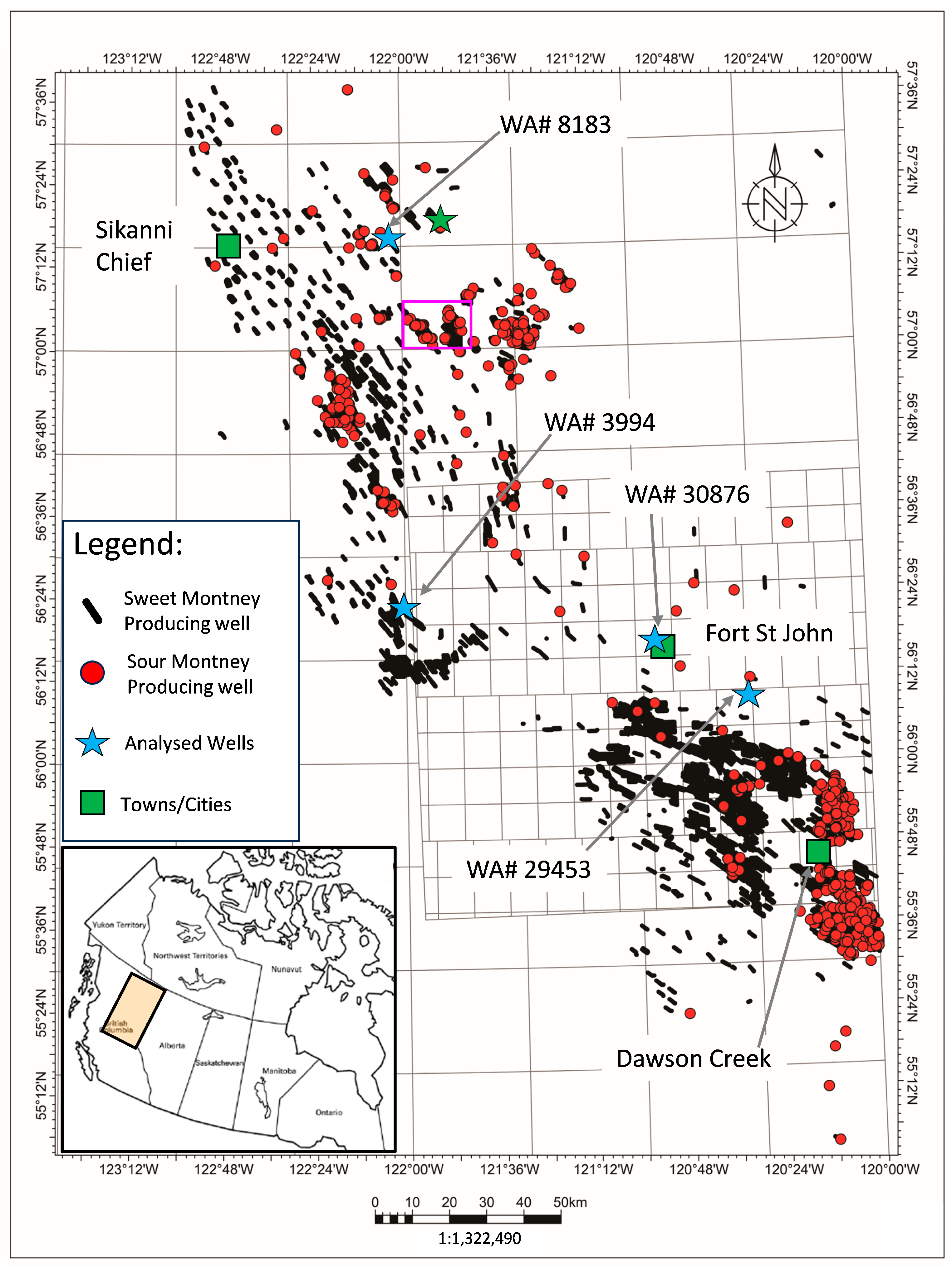
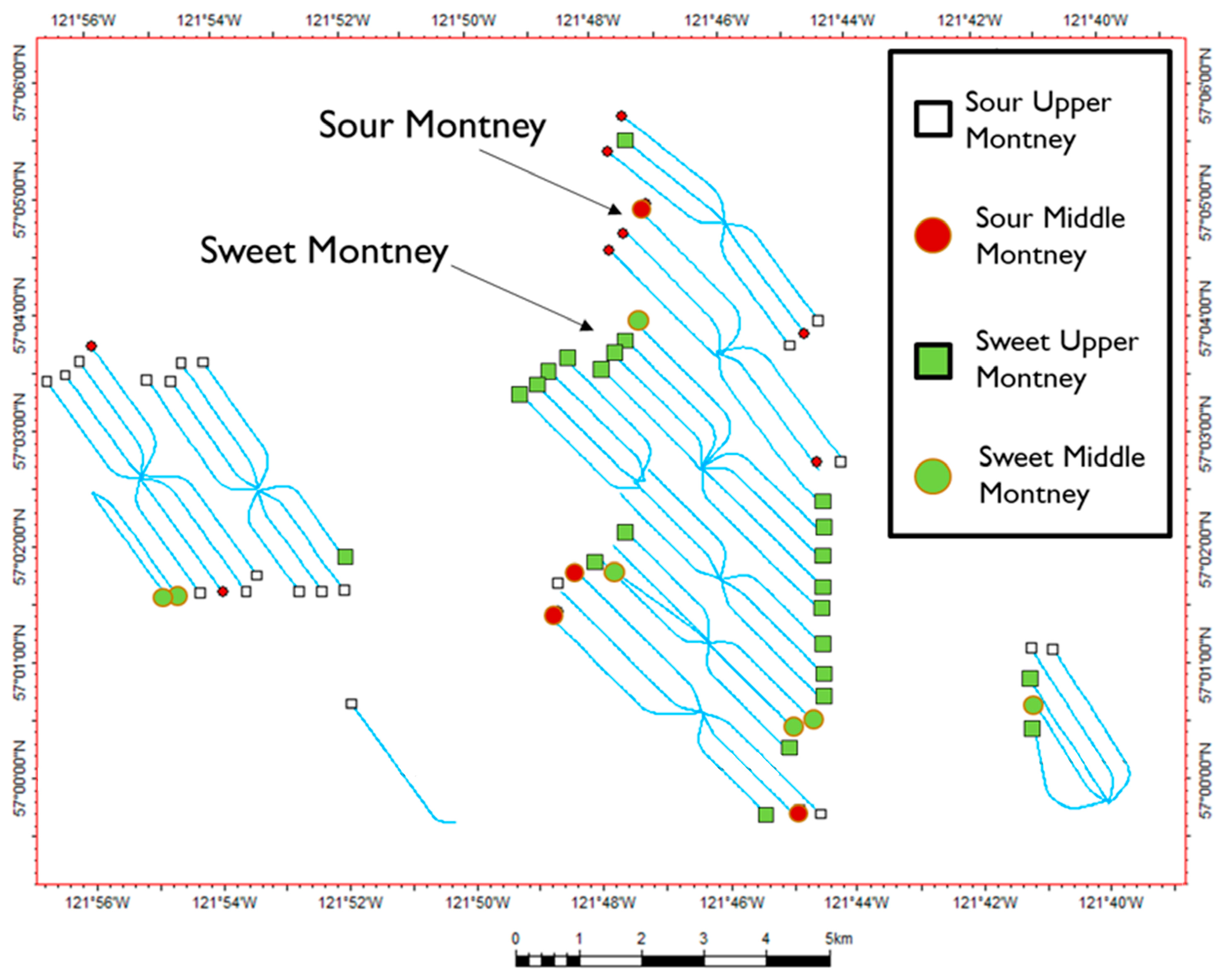
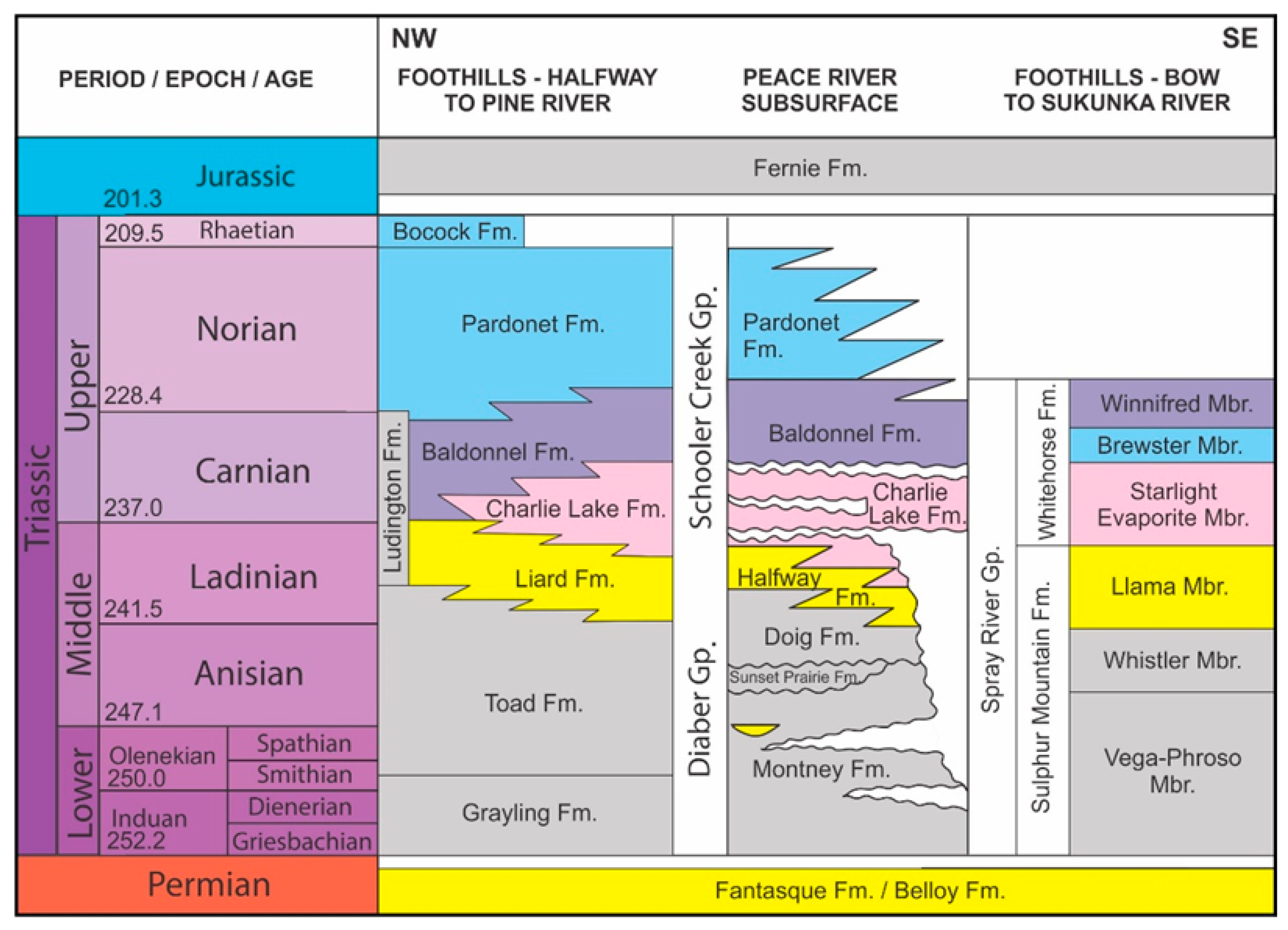
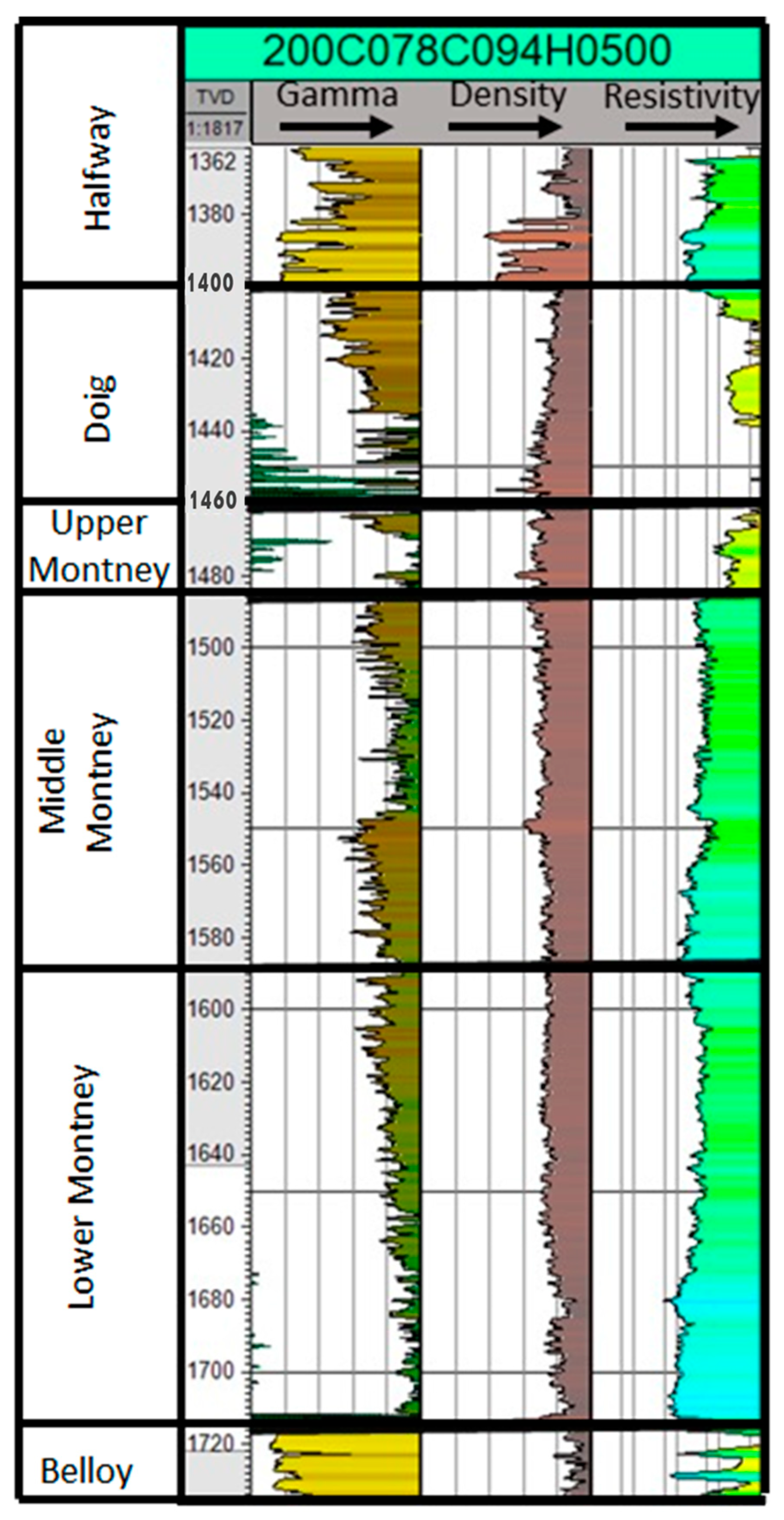
1.2. Geological Background
2. Materials and Methods
2.1. XRD Mineralogical Composition
2.2. Anhydrite, Pyrite, and Organic Matter Separation
2.3. Isotopic Sulphur Analysis—Solids
2.4. Isotopic Sulphur Analysis—H2S Gas
2.5. Scanning Electron Microscopy
3. Results
4. Discussion
4.1. Isotopic Analyses
4.2. TSR versus BSR Processes
4.3. H2S Gas Generation Model
4.4. Future Work
5. Conclusions
Author Contributions
Funding
Data Availability Statement
Conflicts of Interest
Appendix
| Formation | Age | Sample ID | Well Licence | Location | δ34S (VCDT) | δ18O (SMOW) | Sulphur Source |
|---|---|---|---|---|---|---|---|
| Charlie Lake | Triassic | PBN-1 | 30,876 | WCSB | 14.2 | 7.69 | anhydrite |
| Charlie Lake | Triassic | PBN-2 | 30,876 | WCSB | 14.6 | 8.75 | anhydrite |
| Charlie Lake | Triassic | PBN-3 | 30,876 | WCSB | 14.7 | 7.94 | anhydrite |
| Charlie Lake | Triassic | PBN-4 | 30,876 | WCSB | 15 | 8.86 | anhydrite |
| Charlie Lake | Triassic | 29,453-1 | 29,453 | WCSB | 16.22 | 12.38 | anhydrite |
| Charlie Lake | Triassic | 29,453-2 | 29,453 | WCSB | 13.59 | 11.55 | anhydrite |
| Charlie Lake | Triassic | 3944-1 | 3944 | WCSB | 14.84 | 10.78 | anhydrite |
| Charlie Lake | Triassic | 3944-2 | 29,453 | WCSB | 15.02 | 10.88 | anhydrite |
| Charlie Lake | Triassic | 3944-3 | 29,453 | WCSB | 15.77 | 12.26 | anhydrite |
| Charlie Lake | Triassic | 8183-1 | 8183 | WCSB | 14.77 | 10.91 | anhydrite |
| Halfway | Triassic | PBN-5 | 30,876 | WCSB | 17 | 8.14 | anhydrite |
| Halfway | Triassic | 29,453-3 | 29,453 | WCSB | 15.51 | 14.16 | anhydrite |
| Halfway | Triassic | 3944-4 | 29,453 | WCSB | 20.73 | 12.88 | anhydrite |
| Doig Silt | Triassic | PBN-6 | 30,876 | WCSB | 13.2 | 3.96 | anhydrite |
| Doig Silt | Triassic | 29,453-4 | 29,453 | WCSB | 15.5 | 8.85 | anhydrite |
| Doig Silt | Triassic | 3944-5 | 29,453 | WCSB | 20.98 | 13.45 | anhydrite |
| Doig Shale | Triassic | PBN-7 | 30,876 | WCSB | 9.9 | −3.69 | anhydrite |
| Doig Shale | Triassic | 29,453-5 | 29,453 | WCSB | 15.41 | 8.56 | anhydrite |
| Montney (upper) | Triassic | 32,908-1 | 32,908 | WCSB | 9.42 | - | anhydrite |
| Montney (upper) | Triassic | 26,668-1 | 26,668 | WCSB | 8.92 | −2.87 | anhydrite |
| Montney (upper) | Triassic | 3944-6 | 3944 | WCSB | 13.94 | 7.56 | anhydrite |
| Montney (upper) | Triassic | PBN-10 | 30,876 | WCSB | 14.5 | −1.00 | anhydrite |
| Montney (upper) | Triassic | 29,483-6 | 29,453 | WCSB | 14.7 | 8.73 | anhydrite |
| Montney (upper) | Triassic | PBN-11 | 30,876 | WCSB | 13.5 | - | anhydrite |
| Montney (upper) | Triassic | PBN-12A | 30,876 | WCSB | 15.5 | - | anhydrite |
| Montney (middle) | Triassic | 29,453-7 | 29,453 | WCSB | 15.55 | 4.46 | anhydrite |
| Montney (middle) | Triassic | 3944-7 | 3944 | WCSB | 16.96 | 2.95 | anhydrite |
| Montney (lower) | Triassic | PBN-13 | 30,876 | WCSB | 13.3 | 0.2 | anhydrite |
| Montney (lower) | Triassic | 29,453-8 | 29,453 | WCSB | 11.59 | 18.37 | anhydrite |
| Montney (lower) | Triassic | 3944-8 | 3944 | WCSB | 10.92 | −4.04 | anhydrite |
| Belloy | Permian | 3944-9 | 3944 | WCSB | 3.91 | 10.19 | anhydrite |
| Muskeg | Devonian | 8183-2 | 8183 | WCSB | 18.6 | 12.29 | anhydrite |
| Muskeg | Devonian | 8183-3 | 8183 | WCSB | 18.62 | 14.05 | anhydrite |
| Muskeg | Devonian | 8183-4 | 8183 | WCSB | 18.02 | 14.72 | anhydrite |
| Muskeg | Devonian | 8183-2 * | 8183 | WCSB | 18.6 | - | anhydrite |
| Muskeg | Devonian | 8183-3 * | 8183 | WCSB | 18.7 | - | anhydrite |
| Muskeg | Devonian | 8183-4 * | 8183 | WCSB | 17.7 | - | anhydrite |
| Montney (upper) | Triassic | 32,908-2 | 32,908 | WCSB | −4.68 | 5.26 | OM |
| Montney (upper) | Triassic | 32,908-3 | 32,908 | WCSB | 1.8 | 12.2 | OM |
| Montney (upper) | Triassic | 26,668-2 | 26,668 | WCSB | −6.92 | 20.28 | OM |
| Montney (upper) | Triassic | PBN9-1 | 30,876 | WCSB | −3.6 | 7.3 | OM |
| Montney (upper) | Triassic | PBN9-2 | 30,876 | WCSB | 6.39 | 17.82 | OM |
| Montney (upper) | Triassic | PBN9-3 | 30,876 | WCSB | 49.9 | - | pyrite |
| Montney (upper) | Triassic | 32,908-4 | 32,908 | WCSB | 2.9 | - | pyrite |
| Montney (upper) | Triassic | 26,668-4 | 26,668 | WCSB | 21.64 | - | pyrite |
References
- Guidotti, T.L. Hydrogen Sulphide. Occup. Med. 1996, 46, 367–371. [Google Scholar] [CrossRef]
- Burgers, W.; Northrop, P.; Kheshgi, H.; Valencia, J. Worldwide development potential for sour gas. Energy Procedia 2011, 4, 2178–2184. [Google Scholar] [CrossRef]
- Machel, H.G. Some aspects of diagenetic sulphate-hydrocarbon redox reactions. In Diagenesis of Sedimentary Sequences; Geological Society Special Publication No. 36; Marshall, J.D., Ed.; The Geological Society: Oxford, UK, 1987; pp. 15–28. [Google Scholar] [CrossRef]
- Hagar, H.; Foroozesh, J.; Kumar, S.; Zivar, D.; Banan, N.; Dzulkarnain, I. Microbial H2S generation in hydrocarbon reservoirs: Analysis of mechanisms and recent remediation technologies. J. Nat. Gas Sci. Eng. 2022, 106, 104729. [Google Scholar] [CrossRef]
- Hubbard, C.G.; Cheng, Y.; Engelbrekston, A.; Druhan, J.L.; Li, L.; Ajo-Franklin, J.B.; Coates, J.D.; Conrad, M.E. Isotopic insights into microbial sulfur cycling in oil reservoirs. Front. Microbiol. 2014, 5, 480. [Google Scholar] [CrossRef]
- Machel, H.G. Bacterial and thermochemical sulfate reduction in diagenetic settings—Old and new insights. Sediment. Geol. 2001, 140, 143–175. [Google Scholar] [CrossRef]
- Nelson, B.; Eglinton, T.; Seewald, J.; Vairavamurthy, M.; Miknis, F. Transformations in organic sulfur speciation during maturation of Monterey shale: Constraints from laboratory experiments. In Geochemical Transformations of Sedimentary Sulfur; Murthy, A., Vairavamurthy, M., Schoonen, A.A., Eglinton, T.I., Luther, G.W., III, Manowitz, B., Eds.; American Chemical Society: Washington, DC, USA, 1995; Volume 612. [Google Scholar] [CrossRef]
- Pirzadeh, P.; Lesage, K.; Marriott, R. Hydraulic Fracturing Additives and the Delayed Onset of Hydrogen Sulfide in Shale Gas. Energy Fuels 2014, 28, 4993–5001. [Google Scholar] [CrossRef]
- Orr, W.L. Changes in sulfur content and isotopic ratios of sulfur during petroleum maturation—Study of the Big Horn Basin Paleozoic oils. Am. Assoc. Pet. Geol. Bull. 1974, 50, 2295–2318. [Google Scholar] [CrossRef]
- Goldstein, T.; Aizenshtat, Z. Thermochemical sulfate reduction a review. J. Therm. Anal. 1994, 42, 241–290. [Google Scholar] [CrossRef]
- Kirste, D.; Desrocher, S.; Spence, B.; Hoyne, B.; Tsang, B.; Hutcheon, I. Fluid flow, water chemistry, gas chemistry and diagenesis in the subsurface Triassic in Alberta and British Columbia. Bull. Can. Pet. Geol. 1997, 45, 742–764. [Google Scholar] [CrossRef]
- Krouse, H. Sulfur isotope studies and their role in petroleum exploration. J. Geochem. Explor. 1977, 7, 189–211. [Google Scholar] [CrossRef]
- Krouse, H.; Viau, C.; Eliuk, L.; Ueda, A.; Halas, S. Chemical and isotopic evidence of thermochemical sulphate reduction by light hydrocarbon gases in deep carbonate reservoirs. Nature 1988, 333, 415–419. [Google Scholar] [CrossRef]
- Liseroudi, M.; Ardakani, O.; Sanei, H.; Pedersen, P.; Stern, R.; Wood, J. Origin of sulfate-rich fluids in the Early Triassic Montney Formation, Western Canadian Sedimentary Basin. Mar. Pet. Geol. 2020, 114, 104236. [Google Scholar] [CrossRef]
- Machel, H.G. Facies and Diagenesis of the Upper Devonian Nisku Formation in the Subsurface of Central Alberta. Ph.D. Thesis, Dept of Geological Sciences, McGill University, Montreal, QC, Canada, 1985. Available online: https://escholarship.mcgill.ca/concern/theses/rn301203s (accessed on 15 May 2024).
- Simpson, G. Sulfate Reduction and Fluid Chemistry of the Devonian Leduc and Nisku Formations in South-Central Alberta. Ph.D. Thesis, Department of Geology and Geophysics, The University of Calgary, Calgary, AB, Canada, 1999. Available online: https://prism.ucalgary.ca (accessed on 15 May 2024).
- Whittaker, S.; Mountjoy, E. Diagenesis of an Upper Devonian Carbonate-Evaporite Sequence: Birdbear Formation, Southern Interior Plains, Canada. J. Sediment. Res. 1996, 66, 965–975. [Google Scholar] [CrossRef]
- Worden, R.; Smalley, S.; Cross, M. The Influence of Rock Fabric and Mineralogy on Thermochemical Sulfate Reduction: Khuff Formation, Abu Dhabi. J. Sediment. Res. 2000, 70, 1210–1221. [Google Scholar] [CrossRef]
- Yang, C.; Hutcheon, I.; Krouse, H. Fluid inclusion and stable isotopic studies of thermochemical sulphate reduction from Burnt Timber and Crossfield East gas fields in Alberta, Canada. Bull. Can. Pet. Geol. 2001, 49, 149–164. [Google Scholar] [CrossRef]
- Zhu, G.; Zhang, S.; Liang, Y.; Dai, J. Isotopic evidence of TSR origin for natural gas bearing high H2S contents within the Feixianguan Formation of the northeastern Sichuan Basin, southwestern China. Sci. China Ser. D Earth Sci. 2005, 48, 1960–1971. [Google Scholar] [CrossRef]
- Boschetti, T.; Cortecci, G.; Toscani, L.; Iacumin, P. Sulfur and oxygen isotope compositions of Upper Triassic sulfates from northern Apennines (Italy): Paleogeographic and hydrogeochemical implications. Geol. Acta 2011, 9, 129–147. [Google Scholar] [CrossRef]
- Claypool, G.; Holser, W.; Kaplan, I.; Sakai, H.; Zak, I. The age of sulphur and oxygen isotopes in Marine Sulphate and their Mutual Interpretation. Chem. Geol. 1980, 28, 199–260. [Google Scholar] [CrossRef]
- Kampschulte, A.; Strauss, H. The sulfur isotopic evolution of Phanerozoic seawater based on the analysis of structurally substituted sulfate in carbonates. Chem. Geol. 2004, 204, 255–286. [Google Scholar] [CrossRef]
- Newton, R.; Bottrell, S. Stable isotopes of carbon and sulphur as indicators of environmental change: Past and present. J. Geol. Soc. 2007, 164, 691–708. [Google Scholar] [CrossRef]
- Veizer, J.; Ala, D.; Azmy, K.; Bruckschen, P.; Buhl, D.; Bruhn, F.; Carden, G.; Diener, A.; Ebneth, S.; Godderis, Y.; et al. 87Sr/86Sr, δ13C and δ18O evolution of Phanerozoic seawater. Chem. Geol. 1999, 161, 59–88. [Google Scholar] [CrossRef]
- Morad, D.; Nader, F.; Morad, C.; Rossi, C.; Gasparrini, M. Limited thermochemical sulfate reduction in hot, anhydritic, sour gas carbonate reservoirs: The Upper Jurassic Arab Formation, United Arab Emirates. Mar. Pet. Geol. 2019, 106, 30–41. [Google Scholar] [CrossRef]
- Energy Utility Board, Alberta. EUB Completes Groundwork for Future of Sour Gas Development in Alberta Public Safety and Sour Gas Committee Helps Alberta Maintain World’s Tightest Sour Gas Rules; EUB: Calgary, AB, Canada, 2007; Available online: https://www.alberta.ca/ (accessed on 16 April 2024).
- NRCan. British Columbia’s Shale and Tight Resources. Online Natural Resources, Canadian Government Website. 2017. Available online: https://natural-resources.canada.ca/energy/energy-sources-distribution/natural-gas/shale-tight-resources-canada/british-columbias-shale-and-tight-resources/17692 (accessed on 28 January 2024).
- NEB (National Energy Board). Canada’s Energy Future 2018; Supplement: Natural gas production; National Energy Board: Calgary, AB, Canada, 2018; 12p. [Google Scholar]
- Desrocher, S.; Hutcheon, I.; Kirste, D.; Henderson, C.M. Constraints on the generation of H2S and CO2 in the subsurface Triassic, Alberta Basin, Canada. Chem. Geol. 2004, 204, 237–254. [Google Scholar] [CrossRef]
- Meshoulam, A.; Ellis, G.S.; Ahmad, W.S.; Deev, A.; Sessions, A.L.; Tang, Y.; Adkins, J.F.; Liu, J.; Gilhooly, W.P., III; Aizenshtat, Z.; et al. Study of thermochemical sulfate reduction mechanism using compound specific sulphur isotope studies. Geochem. Cosmochim. Acta 2016, 188, 73–92. [Google Scholar] [CrossRef]
- Hunt, A.; Ratcliffe, J. Triassic stratigraphy, Peace River Area, Alberta and British Columbia, Canada. AAPG Bull. 1959, 43, 563–589. [Google Scholar] [CrossRef]
- Desrocher, S. Isotopic and Compositional Characterization of Natural Gases in the Lower and Middle Triassic Montney, Halfway, and Doig Formations, Alberta Basin. Master’s Thesis, University of Calgary, Calgary, AB, Canada, 1997; 218p. [Google Scholar]
- Zonneveld, J.-P.; Carrelli, G.; Riediger, C. Sedimentology of the Upper Triassic Charlie Lake, Baldonnel and Pardonet Formations from Outcrop Exposures in the Southern Trutch Region, Northeastern British Columbia. Bull. Can. Pet. Geol. 2004, 52, 343–375. [Google Scholar] [CrossRef]
- White, T.; Al-Aasm, I. Hydrothermal dolomitization of the Mississippian Upper Debolt Formation, Sikanni gas field, northeastern British Columbia, Canada. Bull. Can. Pet. Geol. 1997, 45, 297–316. [Google Scholar] [CrossRef]
- Davies, G. The Triassic of the Western Canada Sedimentary Basin: Tectonic and stratigraphic framework, paleogeography, paleoclimate and biota. Bull. Can. Pet. Geol. 1997, 45, 434–460. [Google Scholar] [CrossRef]
- Davies, G.R.; Moslow, T.F.; Sherwin, M.D. The Lower Triassic Montney Formation, west-central Alberta. Bull. Can. Pet. Geol. 1997, 45, 474–505. [Google Scholar] [CrossRef]
- Sharma, G. Paragenetic evolution in Peejay Field, British Columbia, Canada. Miner. Depos. 1969, 4, 346–354. [Google Scholar] [CrossRef]
- Harris, R.G. Sedimentology and Reservoir Characteristics of Triassic Doig Sand Bodies at West Stoddart and Cache Creek in Northeastern British Columbia. Master’s Thesis, University of British Columbia, Vancouver, BC, Canada, 2000; 205p. [Google Scholar]
- Markhasin, B. Sedimentology and Stratigraphy of the Lower Triassic Montney Formation, Subsurface of Northwestern Alberta. Master’s Thesis, University of Calgary, Calgary, AB, Canada, 1997; 153p. [Google Scholar] [CrossRef]
- Furlong, C.M.; Gingras, M.K.; Moslow, T.F.; Zonneveld, J.-P. The Sunset Prairie Formation: Designation of a new Middle Triassic formation between the Lower Triassic Montney Formation and Middle Triassic Doig Formation in the Western Canada Sedimentary Basin, northeast British Columbia. Bull. Can. Pet. Geol. 2018, 66, 193–214. [Google Scholar] [CrossRef]
- Golding, M.L.; Orchard, M.J.; Zonneveld, J.-P.; Wilson, N.S.F. Determining the age and depositional model of the Doig phosphate zone in northeastern British Columbia using conodont biostratigraphy. Bull. Can. Pet. Geol. 2015, 63, 143–170. [Google Scholar] [CrossRef]
- Gibson, D.W.; Barclay, J.E. Middle Absaroka Sequence—The Triassic stable craton. In Western Canada Sedimentary Basin—A Case History; Ricketts, B.D., Ed.; Canadian Society of Petroleum Geologists: Calgary, AB, Canada, 1989; pp. 219–232. [Google Scholar]
- Embry, A.F.; Gibson, D.W. T-R sequence analysis of the Triassic succession of the Western Canada Sedimentary Basin. In Proceedings of the Oil and Gas Forum ’95—Energy from Sediments, Calgary, AB, Canada, 28–29 March 1995; Geological Survey of Canada: Calgary, AB, Canada, 1995; pp. 25–32. [Google Scholar]
- Hardenbol, J.; Thierry, J.; Farley, M.B.; Jacquin, T.; de Graciansky, P.-C.; Vail, P.R. Mesozoic and Cenozoic sequence chronostratigraphic framework of European basins. In Mesozoic and Cenozoic Sequence Stratigraphy of European Basins; De Graciansky, P.-C., Hardenbol, J., Jacquin, T., Vail, P.R., Eds.; SEPM Special Publication 60; Society for Sedimentary Geology: Tulsa, OK, USA, 1999. [Google Scholar] [CrossRef]
- Davies, G.R.; Watson, N.; Moslow, T.F.; MacEachern, J.A. Regional subdivisions, sequences, correlations and facies relationships of the lower Triassic Montney Formation, west-central Alberta to northeastern British Columbia, Canada—With emphasis on role of paleostructure. Bull. Can. Pet. Geol. 2018, 66, 23–92. [Google Scholar]
- Edwards, D.E.; Barclay, J.E.; Gibson, D.W.; Kvill, G.E.; Halton, E. Triassic strata of the Western Canada Sedimentary Basin. In Geological Atlas of the Western Canada Sedimentary Basin; Mossop, G.D., Shetsen, I., Eds.; Canadian Society of Petroleum Geologists and the Alberta Research Council: Calgary, AB, Canada, 1994; pp. 259–275. [Google Scholar]
- Walsh, W.; Adams, C.; Kerr, B.; Korol, J. Regional “Shale Gas” Potential of the Triassic Doig and Montney Formations, Northeastern British Columbia: Petroleum Geology Open File 2006-02; British Columbia Ministry of Energy Mines and Petroleum Resources: Victoria, BC, Canada, 2006; 19p. [Google Scholar]
- Dixon, J. Triassic stratigraphy in the subsurface of the plains area of Dawson Creek (94A) and Charlie Lake (94A) map areas, northeast British Columbia. Bull. Geol. Surv. Can. 2009, 595, 78. [Google Scholar] [CrossRef]
- Chalmers, G.R.L.; Bustin, R.M. Geological evaluation of Halfway-Doig-Montney hybrid gas shale-tight gas reservoir, northeastern British Columbia. Mar. Pet. Geol. 2012, 38, 53–72. [Google Scholar] [CrossRef]
- Gonzalez, P.; Furlong, C.; Gingras, M.; Payter, T.; Zonneveld, J.P. Depositional framework and trace fossil assemblages of the Lower Triassic Montney Formation, northeastern British Columbia, Western Canada Sedimentary Basin. Mar. Pet. Geol. 2022, 143, 105822. [Google Scholar] [CrossRef]
- Rohais, S.; Crombez, V.; Euzen, T.; Baudin, F. The Lower and Middle Triassic of Western Canada: Passive margin, back-arc or fore-arc geodynamic setting? In Proceedings of the Geoconvention 2016: Optimizing Resources, Calgary, AB, Canada, 7–11 March 2016. [Google Scholar]
- Silva, P.L.; Bustin, R.M. Basin-wide unconventional potential of the Doig Formation, Triassic of the Western Canada Sedimentary Basin. Mar. Pet. Geol. 2023, 155, 106394. [Google Scholar] [CrossRef]
- Kent, D.M. Paleogeographic evolution of the cratonic platform-Cambrian to Triassic. In Geological Atlas of the Western Canada Sedimentary Basin; Mossop, G.D., Shetsen, I., Eds.; Canadian Society of Petroleum Geologists and the Alberta Research Council: Calgary, AB, Canada, 1994; pp. 69–86. [Google Scholar]
- Dixon, J. Regional lithostratigraphic units in the Triassic Montney Formation of western Canada. Bull. Can. Pet. Geol. 2000, 48, 80–83. [Google Scholar] [CrossRef]
- Utting, J.; MacNaughton, R.B.; Zonneveld, J.-P.; Fallas, K.M. Palynostratigraphy, lithostratigraphy and thermal maturity of the Lower Triassic Toad and Grayling, and Montney formations of western Canada, and comparisons with coeval rocks of the Sverdrup basin, Nunavut. Bull. Can. Pet. Geol. 2005, 53, 5–24. [Google Scholar] [CrossRef]
- Berger, Z.; Boast, M.; Mushayandebvu, M. The contribution of integrated HRAM studies to exploration and exploitation of unconventional plays in North America. Part 1: The Peace River Arch. Reservoir 2008, 35, 42–47. [Google Scholar]
- Chalmers, G.R.L.; Lacerda Silva, P.; Bustin, A.A.; Sanlorenzo, A.; Bustin, R.M. Geology and Geochemistry of the Hydrocarbon Compositional Changes in the Triassic Montney Formation, Western Canada. Energies 2022, 15, 8677. [Google Scholar] [CrossRef]
- Berger, Z.; Boast, M.; Mushayandebvu, M. The contribution of integrated HRAM studies to exploration and exploitation of unconventional plays in North America. Part 2: Basement structures control on the development of the Peace River Arch’s Montney/Doig resource plays. Reservoir 2009, 36, 40–45. [Google Scholar]
- Munson, E.O.; Chalmers, G.R.L.; Bustin, R.M.; Li, K. Utilizing smear mounts for X-ray diffraction as a fully quantitative approach in rapidly characterizing the mineralogy of shale gas reservoirs. J. Unconv. Oil Gas Resour. 2016, 14, 22–31. [Google Scholar] [CrossRef]
- Rietveld, H.M. Line profiles of neutron powder-diffraction peaks for structure refinement. Acta Crystallogr. 1967, 22, 151–152. [Google Scholar] [CrossRef]
- Warren, J. Interpreting evaporite textures. In Evaporites: A Geological Compendium; Warren, J., Ed.; Springer: Cham, Switzerland, 2016; 1813p. [Google Scholar] [CrossRef]
- Decraene, M.; Marin-Carbonne, J.; Thomazo, C.; Brayard, A.; Bouvier, A.; Bomou, B.; Adatte, T.; Olivier, N. Pyrite iron isotope compositions track local sedimentation conditions through the Smithian-Spathian transition (Early Triassic, Utah, USA). Palaeogeog. Palaeoclim. Palaeoecol. 2023, 617, 111507. [Google Scholar] [CrossRef]
- Cui, H.; Kitajima, K.; Spicuzza, M.; Fournelle, J.; Denny, A.; Ishida, A.; Zhang, F.; Valley, J. Questioning the biogenicity of Neoproterozoic superheavy pyrite by SIMS. Am. Mineral. 2018, 103, 1362–1400. [Google Scholar] [CrossRef]
- Luo, K.; Zhou, J.; Ju, Y. A shift from BSR to TSR caused the formation of the Chipu Pb-Zn deposit, South China. Ore Geol. Rev. 2022, 144, 104845. [Google Scholar] [CrossRef]
- Pasquier, V.; Fike, D.A.; Halevy, I. Sedimentary pyrite sulfur isotopes track the local dynamics of the Peruvian oxygen minimum zone. Nat. Commun. 2012, 12, 4403. [Google Scholar] [CrossRef]
- Chalmers, G.R.L.; Bustin, R.M.; Bustin, A.A. Stratigraphic and lateral distribution of hydrogen sulphide within the Triassic Montney Formation, northern regional play area, northeastern British Columbia and northwestern Alberta. In Geoscience BC Summary of Activities 2018: Energy and Water; Report 2019-2; Geoscience BC: Vancouver, BC, Canada, 2019; pp. 43–46. Available online: https://www.geosciencebc.com/summary-of-activities-2018-energy-and-water/ (accessed on 15 May 2024).
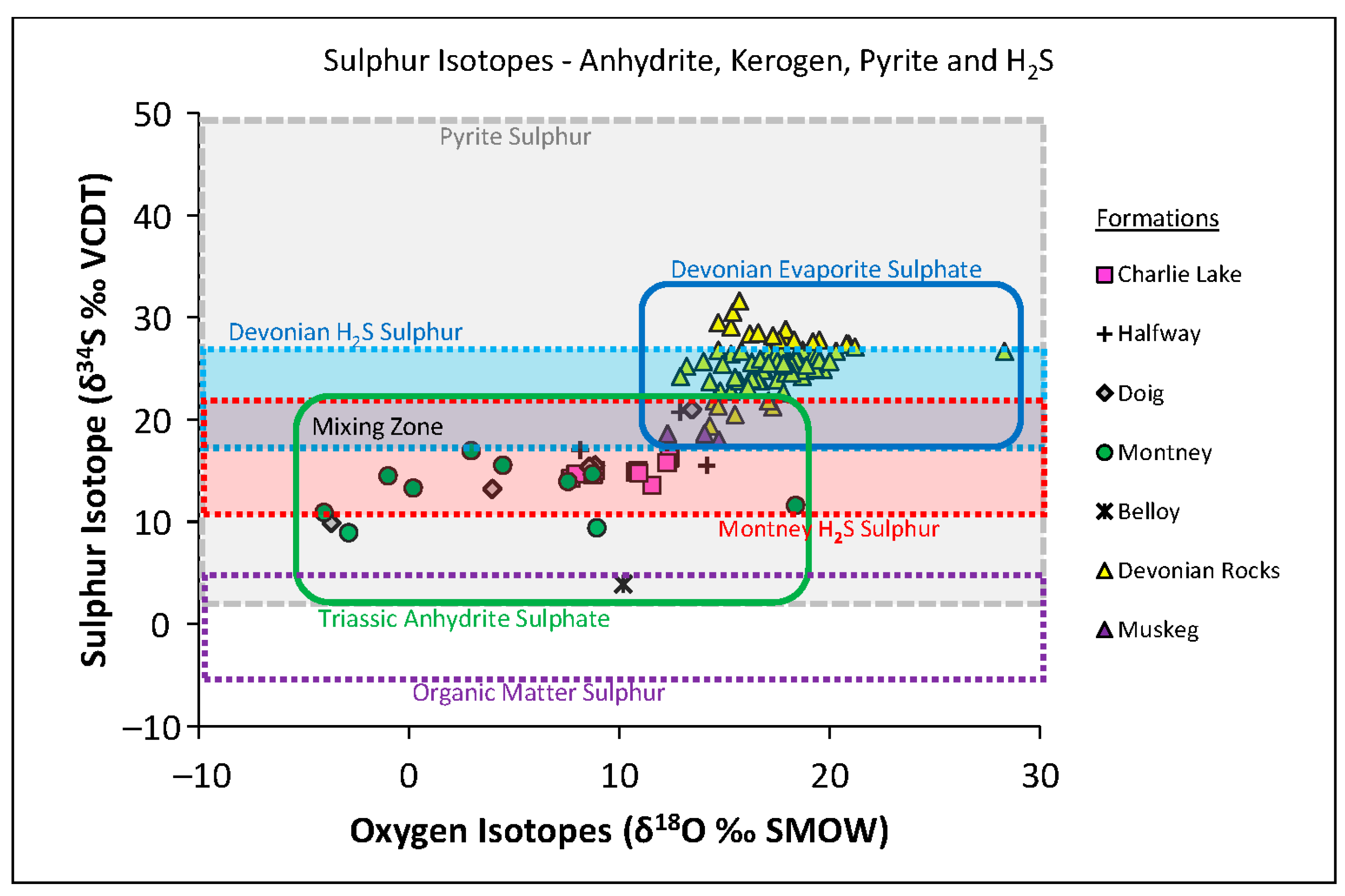
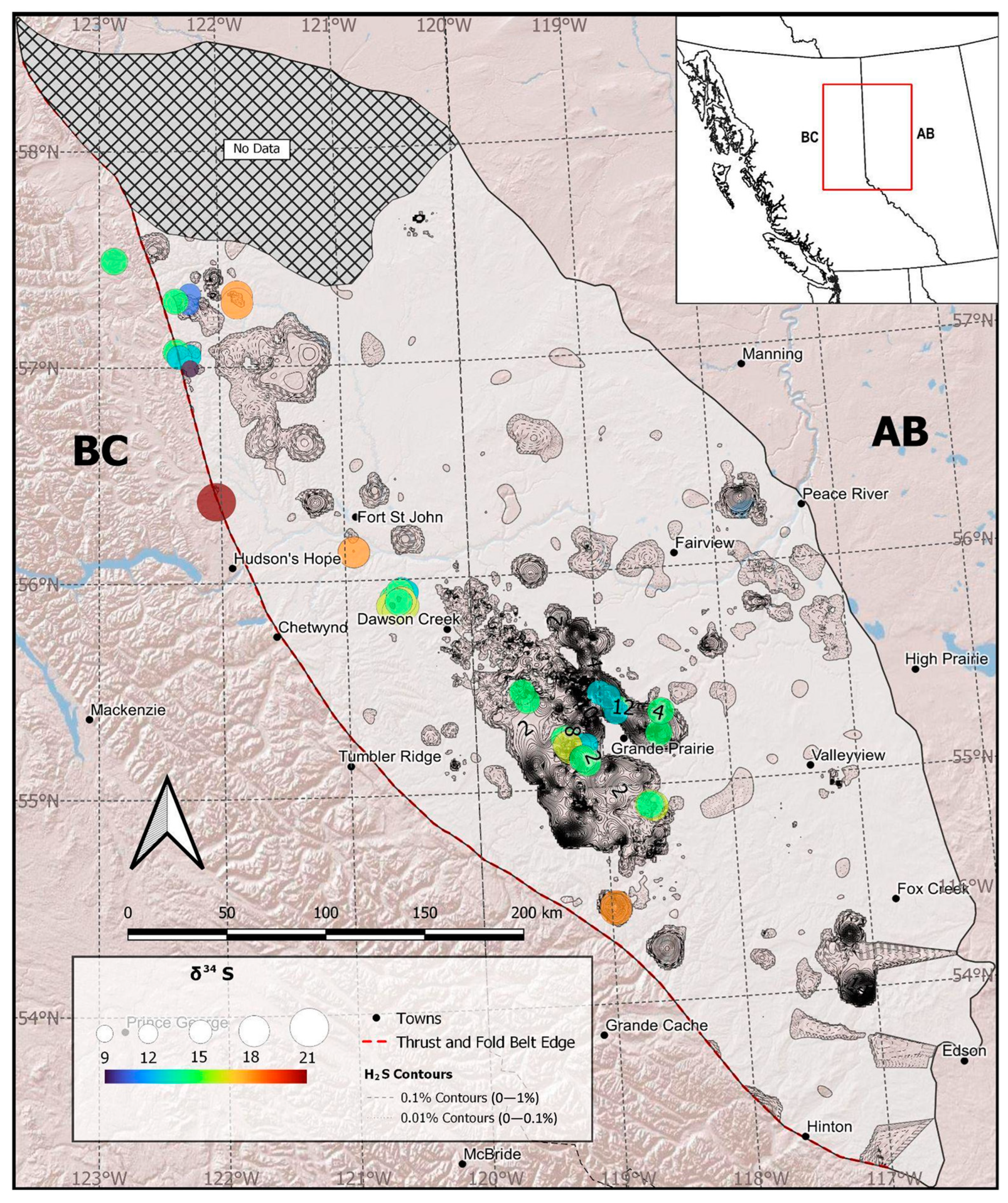
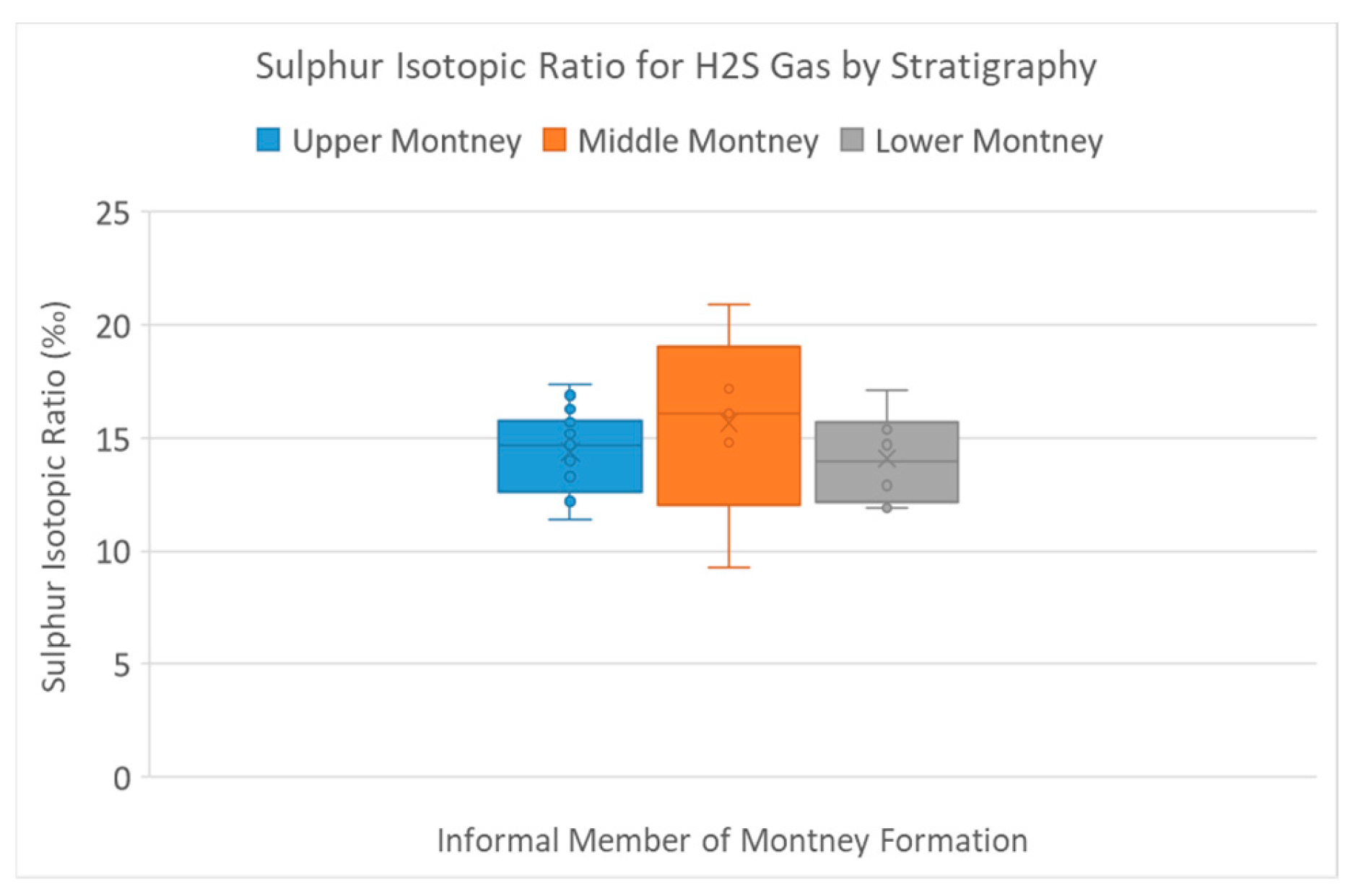
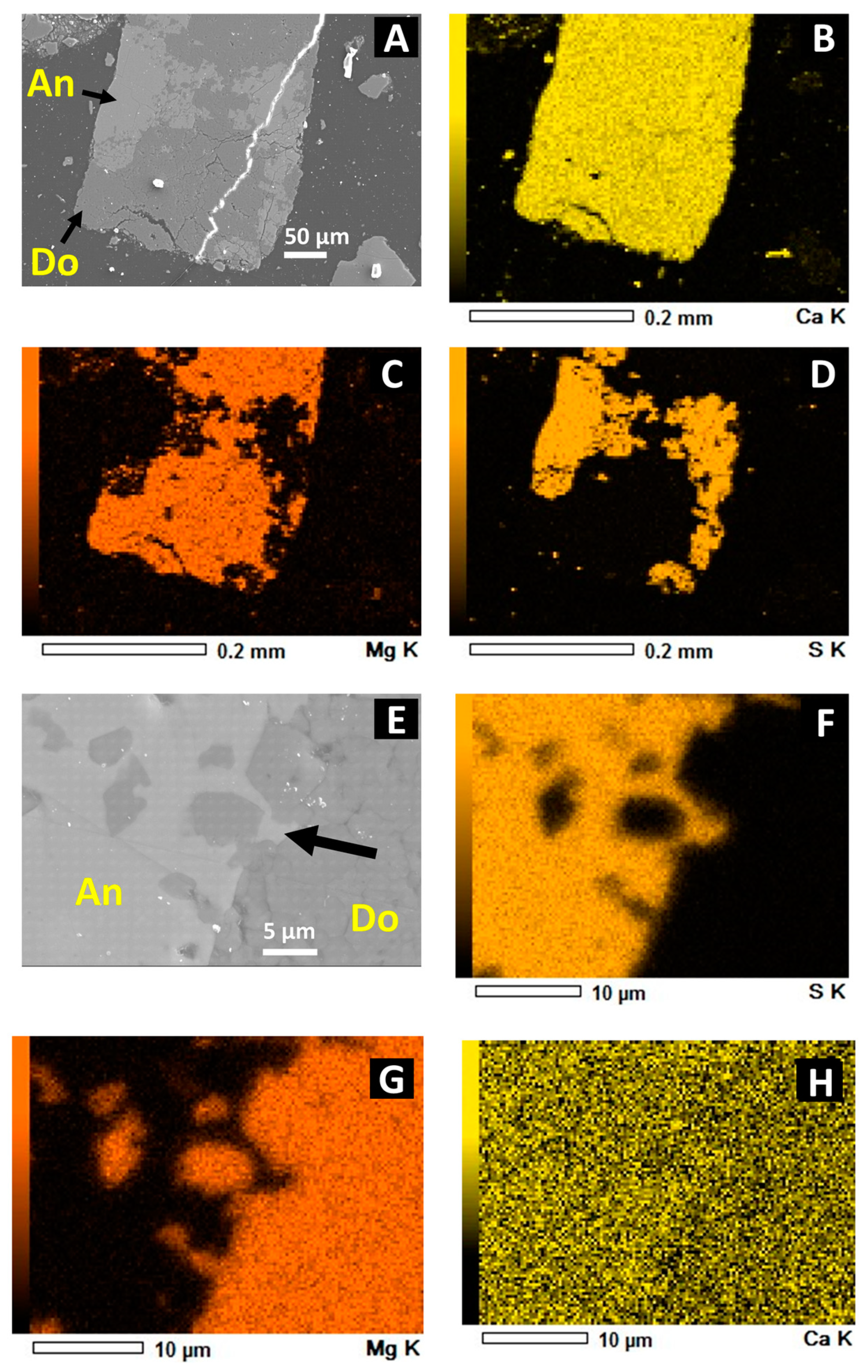
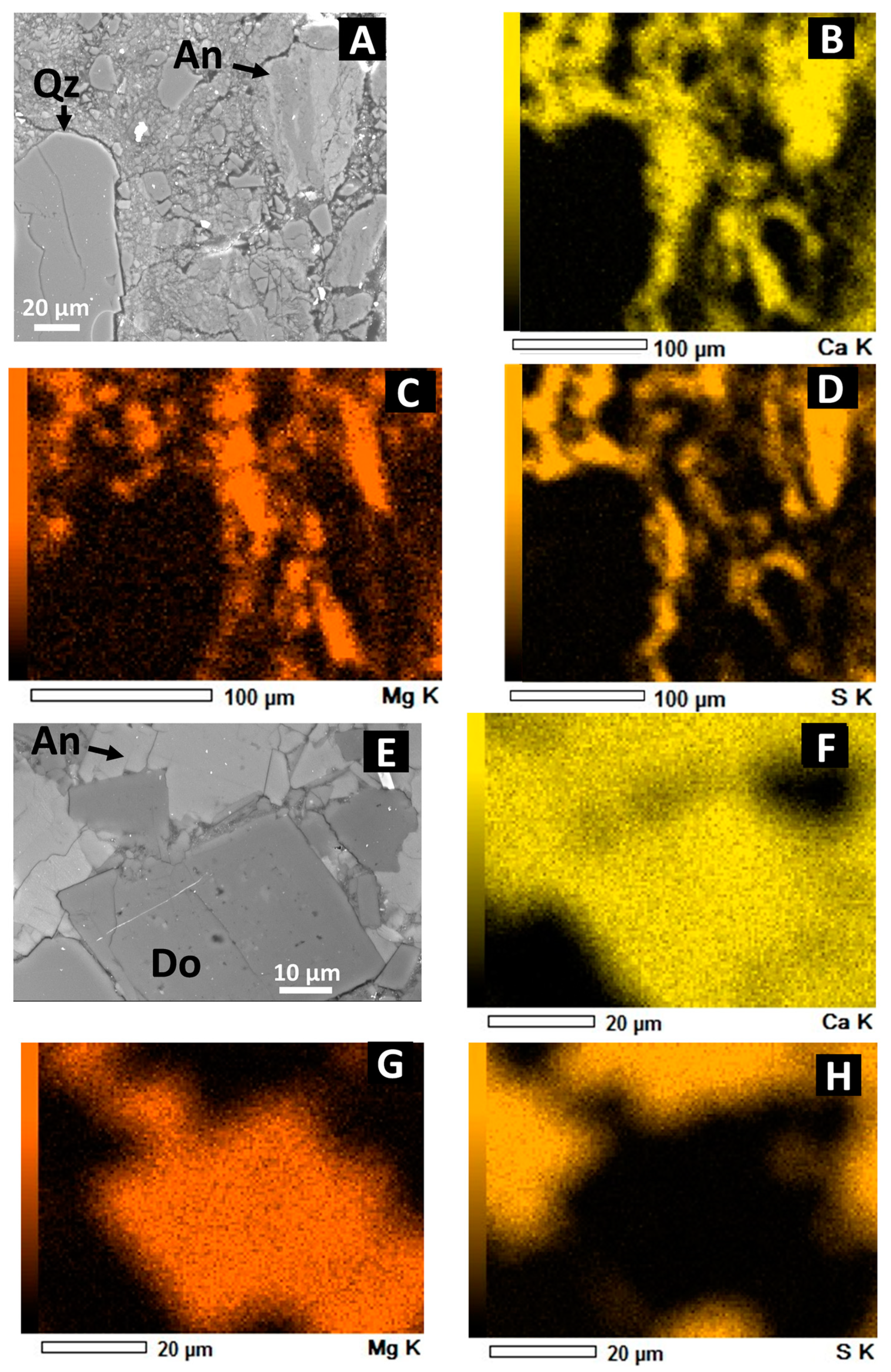
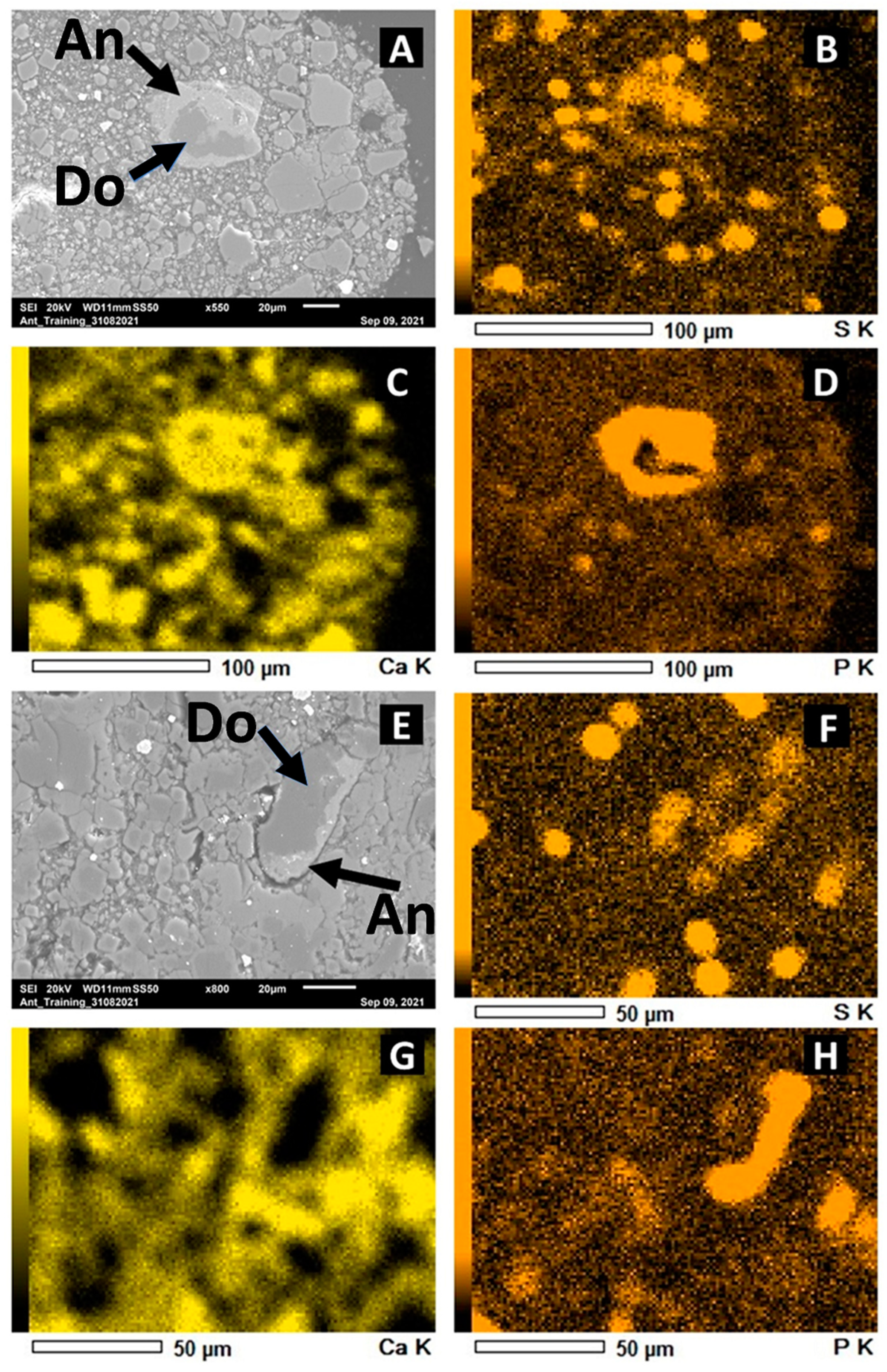
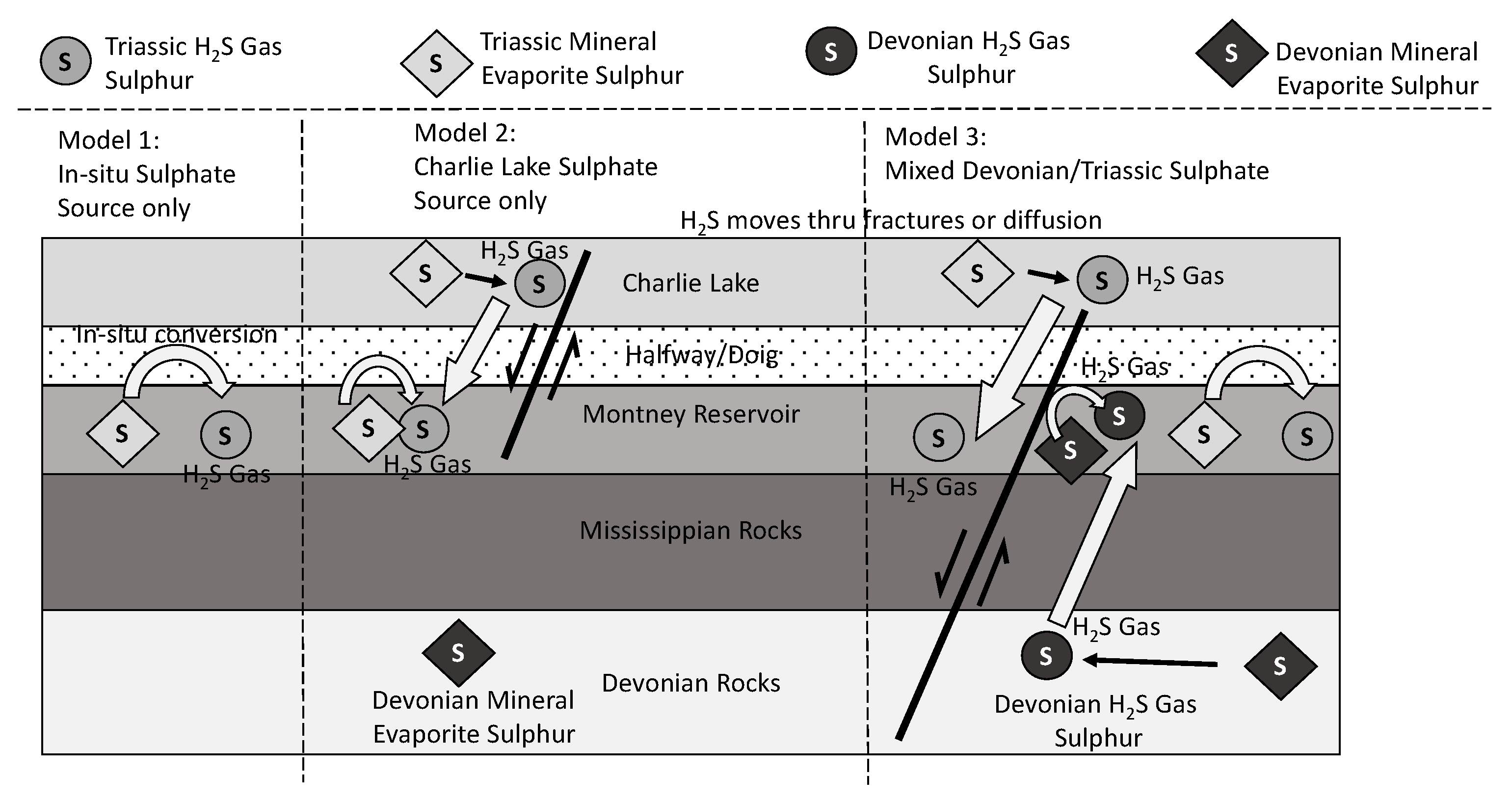
| Sample ID | Well Licence Number | Formation | Depth (m) | Anhydrite | Gypsum | Pyrite | Quartz | Dolomite | Calcite | Illite/Muscovite * 1M | Chlorite | Apatite (Fluor-) ‡ | Albite | Microcline | Orthoclase |
|---|---|---|---|---|---|---|---|---|---|---|---|---|---|---|---|
| PBN-1 | 30,876 | C.L. | 1392 | 42.6 | 0.3 | 0 | 9.1 | 36.5 | 1.7 | 2.5 | 0 | 0 | 1.5 | 0 | 6 |
| PBN-2 | 30,876 | C.L. | 1430 | 19.9 | 0.1 | 0 | 11.5 | 50.8 | 3.8 | 3 | 0 | 0 | 1.3 | 0 | 9.6 |
| PBN-3 | 30,876 | C.L. | 1467 | 21.7 | 0 | 0 | 14.6 | 39.7 | 3.7 | 5.6 | 2.4 | 0 | 5.8 | 6.6 | 0 |
| PBN-4 | 30,876 | C.L. | 1542 | 18.6 | 0 | 0 | 13.1 | 39.6 | 9.6 | 6.6 | 2.2 | 0 | 2.8 | 7.5 | 0 |
| PBN-5 | 30,876 | HFY | 1597 | 0.4 | 0.1 | 0.8 | 65.5 | 18.6 | 3.7 | 1.6 | 0 | 0 | 1.2 | 8 | 0 |
| PBN-6 | 30,876 | Doig | 1642 | 0.4 | 0 | 1.2 | 31.5 | 20.3 | 29.8 | 1.4 | 0 | 7 | 1.6 | 7 | 0 |
| PBN-7 | 30,876 | Doig | 1722 | 0.7 | 0 | 1.5 | 21.5 | 22.4 | 18 | 9.2 | 0.2 | 5.9 | 3.7 | 17 | 0 |
| PBN-8 | 30,876 | Doig | 1757 | 0.3 | 0 | 2.4 | 19.7 | 19.2 | 33.2 | 3.6 | 0 | 7.3 | 1.4 | 12.9 | 0 |
| PBN-9 | 30,876 | Mont. | 1770 | 0.9 | 0 | 1.7 | 33.9 | 17.3 | 14.9 | 3.2 | 0 | 2.5 | 3.7 | 4.7 | 17.2 |
| PBN-10 | 30,876 | Mont. | 1790 | 1 | 0 | 2.2 | 26.7 | 20.1 | 6.7 | 4.5 | 0 | 0.3 | 2 | 5.4 | 31 |
| PBN-11 | 30,876 | Mont. | 1815 | 0.9 | 0 | 1.8 | 27.8 | 18.8 | 3.2 | 5.9 | 1.1 | 0 | 2.3 | 5.9 | 32.2 |
| PBN-12 | 30,876 | Mont. | 1857 | 0.6 | 0 | 2.4 | 30.9 | 18.3 | 6.4 | 6.4 | 1.8 | 0 | 2.1 | 5.3 | 26 |
| PBN-13 | 30,876 | Mont. | 1972 | 0.6 | 0 | 2.6 | 25.8 | 15.8 | 6.8 | 6.8 | 3 | 0 | 1.8 | 7 | 29.9 |
| PBN-14 | 30,876 | Belloy | 2073 | 0.6 | 1.7 | 0.5 | 9.4 | 82.4 | 3.3 | 0 | 0.5 | 0 | 0.5 | 1.1 | 0 |
| CL 5570 | 3944 | C.L. | 1698 | 17.6 | 1.6 | 0 | 11.4 | 39.9 | 0.3 | 19.4 | 2.3 | 0 | 7.7 | 0 | 0 |
| CL 5620 | 3944 | C.L. | 1713 | 22 | 1.8 | 0 | 8.2 | 45 | 0.6 | 16.3 | 1.2 | 0 | 4.9 | 0 | 0 |
| CL 5650 | 3944 | C.L. | 1722 | 16.9 | 1.8 | 0 | 15.2 | 35.5 | 4.6 | 18.9 | 1.7 | 0 | 5.4 | 0 | 0 |
| CL 6010 | 3944 | C.L. | 1832 | 5.9 | 1.3 | 0 | 18.9 | 41.8 | 7.5 | 18.3 | 1.7 | 0 | 4.7 | 0 | 0 |
| HF 6280 | 3944 | HFY | 1914 | 0.7 | 0 | 0 | 44.6 | 18.8 | 22.5 | 10.1 | 0 | 0 | 3.4 | 0 | 0 |
| HF 6400 | 3944 | HFY | 1916 | 3.3 | 0 | 0 | 44.7 | 29.4 | 2.7 | 11.7 | 0.2 | 0 | 7.9 | 0 | 0 |
| Doig 6570 | 3944 | Doig | 1951 | 3.7 | 2.6 | 0 | 40.1 | 21 | 0 | 21.6 | 0 | 1.3 | 9.7 | 0 | 0 |
| UM 6870 | 3944 | Mont. | 2094 | 1 | 0 | 1.7 | 30.5 | 15.7 | 7.7 | 23.9 | 1.8 | 0.8 | 17 | 0 | 0 |
| UM 7180 | 3944 | Mont. | 2189 | 1.9 | 0 | 1.3 | 33 | 24.4 | 7.7 | 16.7 | 0 | 1.3 | 14 | 0 | 0 |
| MM7670 | 3944 | Mont. | 2338 | 1.5 | 0 | 1.2 | 36.6 | 18.2 | 5.6 | 16.3 | 7.4 | 1.3 | 12 | 0 | 0 |
| LM 7930 | 3944 | Mont. | 2417 | 0.4 | 0 | 2.7 | 30.3 | 10.7 | 3.7 | 38.1 | 5.6 | 0 | 8.7 | 0 | 0 |
| Bell 1875 | 3944 | Belloy | 2451 | 0 | 0 | 1.5 | 48.6 | 9.8 | 32.5 | 32.5 | 0.1 | 0 | 3.3 | 0 | 0 |
| DEB 8180 | 3944 | Debolt | 2493 | 0 | 0 | 0 | 4.4 | 0 | 95.4 | 0 | 0 | 0 | 0.2 | 0 | 0 |
| DEB 8110 | 3944 | Debolt | 2472 | 0 | 0 | 0 | 2.7 | 0 | 97.2 | 0 | 0 | 0 | 0.1 | 0 | 0 |
| CL 1425 | 8183 | C.L. | 1425 | 5.6 | 0 | 0 | 19.1 | 37.1 | 0 | 29.3 | 6.4 | 0 | 2.6 | 0 | 0 |
| Cl 1480 | 8183 | C.L. | 1480 | 1.2 | 0 | 0 | 45.3 | 16.2 | 6.6 | 18.4 | 0.7 | 0 | 12 | 0 | 0 |
| HY 1530 | 8183 | HFY | 1530 | 0.3 | 0 | 0 | 57.1 | 17 | 1.3 | 14.5 | 0.8 | 0 | 9 | 0 | 0 |
| Doig 1585 | 8183 | Doig | 1585 | 0.7 | 0 | 1.3 | 24.8 | 22.4 | 15.3 | 23.2 | 0 | 4 | 8.3 | 0 | 0 |
| UM 1675 | 8183 | Mont. | 1675 | 0.7 | 0 | 2.1 | 24.3 | 18.9 | 22.1 | 22.4 | 1 | 0 | 6.2 | 0 | 0 |
| MM 1780 | 8183 | Mont. | 1750 | 1.3 | 0 | 2 | 29 | 16.2 | 14.6 | 23 | 4.2 | 0 | 7.6 | 0 | 0 |
| LM 1827 | 8183 | Mont. | 1827 | 0.2 | 0 | 2.7 | 33.1 | 14.3 | 4.2 | 33.3 | 8.4 | 0 | 3.8 | 0 | 0 |
| BEL 1875 | 8183 | Belloy | 1875 | 0.4 | 0 | 2.8 | 27.5 | 9.1 | 2.8 | 36 | 5.4 | 2 | 14 | 0 | 0 |
| DEB 1915 | 8183 | Debolt | 1915 | 0.4 | 0 | 0 | 2.2 | 3.7 | 77.8 | 15.6 | 0.1 | 0 | 0.2 | 0 | 0 |
| DEB 2130 | 8183 | Debolt | 2130 | 0.1 | 0 | 0 | 5.1 | 4.4 | 72 | 18.2 | 0 | 0 | 0.2 | 0 | 0 |
| DEB 2270 | 8183 | Debolt | 2270 | 0 | 0 | 0 | 12.6 | 5.5 | 56.5 | 23.8 | 0.5 | 0 | 0.5 | 0 | 0 |
| DEB 2690 | 8183 | Debolt | 2690 | 0.2 | 0 | 0 | 6.6 | 4.6 | 73.7 | 12.2 | 2.3 | 0 | 0.5 | 0 | 0 |
| DEB 2855 | 8183 | Debolt | 2855 | 0.2 | 0 | 0 | 17.8 | 7.2 | 36.4 | 25.6 | 11.6 | 1.2 | 0 | 0 | 0 |
| DEB 2935 | 8183 | Debolt | 2935 | 0.2 | 0 | 0 | 23.8 | 5 | 12.4 | 36 | 21.5 | 0 | 1.1 | 0 | 0 |
| DEB 8183 | 8183 | Debolt | 3055 | 0.3 | 0 | 1.6 | 14.3 | 8.9 | 0.3 | 40.9 | 29.4 | 0 | 4.2 | 0 | 0 |
| SP 3302 | 8183 | S.P. | 3302 | 0 | 0 | 1.4 | 10.4 | 54.4 | 17.8 | 15.1 | 0.5 | 0 | 0.4 | 0 | 0 |
| SP 3342 | 8183 | S.P. | 3342 | 0 | 0 | 0.6 | 16.2 | 41.6 | 14.3 | 26.1 | 0.6 | 0 | 0.7 | 0 | 0 |
| SP 3326 | 8183 | S.P. | 3326 | 0.3 | 0 | 0 | 16.9 | 5 | 0.9 | 34.8 | 26.6 | 0 | 15 | 0 | 0 |
| SP 3400 | 8183 | S.P. | 3400 | 0.1 | 0 | 0.5 | 3 | 10.4 | 69.3 | 15.9 | 0.6 | 0 | 0.3 | 0 | 0 |
| CL 1590 | 29,453 | C.L. | 1590 | 6.4 | 0 | 0 | 10.7 | 34.3 | 22.7 | 21.8 | 0.9 | 0 | 3.2 | 0 | 0 |
| CL 1805 | 29,453 | C.L. | 1805 | 9.8 | 0 | 0 | 12.9 | 39.1 | 5.6 | 28.6 | 1.1 | 0 | 3 | 0 | 0 |
| HF 1880 | 29,453 | HFY | 1880 | 1 | 0 | 0.7 | 56.3 | 10.9 | 6.1 | 24.1 | 0.2 | 0 | 0.8 | 0 | 0 |
| Doig 1888 | 29,453 | Doig | 1888 | 3.1 | 0 | 0.6 | 34.8 | 12.1 | 11.7 | 21.7 | 0.8 | 6.4 | 8.9 | 0 | 0 |
| Doig 1940 | 29,453 | Doig | 1940 | 3 | 0 | 1.2 | 16.6 | 14.3 | 25.6 | 24.3 | 1.5 | 4.5 | 9 | 0 | 0 |
| UM 2004 | 29,453 | Mont. | 2004 | 1.3 | 0 | 1.2 | 32.1 | 22.5 | 8.9 | 28 | 0.2 | 0 | 5.8 | 0 | 0 |
| MM 2140 | 29,453 | Mont. | 2140 | 2.9 | 0 | 1.5 | 28.9 | 22.2 | 5.6 | 29.2 | 0.4 | 0 | 8.3 | 0 | 0 |
| LM 2250 | 29,453 | Mont. | 2250 | 1.6 | 0 | 1.2 | 29.1 | 15.9 | 6.5 | 31 | 8.2 | 0 | 6.5 | 0 | 0 |
| LM 2330 | 29,453 | Mon Hz | 2330 | 1.1 | 0 | 0.8 | 23.7 | 20.9 | 5.7 | 33.7 | 7.4 | 0 | 6.8 | 0 | 0 |
| UWID | δ34S (VCDT) | Latitude | Longitude | Sample Depth (m; TVD) | Formation or Zone |
|---|---|---|---|---|---|
| 100/01-29-082-19W6/02 | 17.4 | 56.13250 | −120.929690 | 1794.5 | Montney (Upper) |
| 100/01-29-082-19W6/02 | 16.9 | 56.13250 | −120.929690 | 1794.5 | Montney (Upper) |
| 200/a-064-h 094-b-08/00 | 12.4 | 56.38534 | −122.042120 | 2127.6 | Montney (Upper) |
| 200/a-064-h 094-b-08/00 | 12.5 | 56.38534 | −122.042120 | 2127.6 | Montney (Upper) |
| 203/d-010-G 094-G-08/00 | 12.2 | 57.33831 | −122.242510 | 1707.8 | Montney (Upper) |
| 202/c-050-B 094-G-08/00 | 11.4 | 57.29098 | −122.250180 | 1777.5 | Montney (Upper) |
| 202/c-070-B 094-G-01/00 | 12.6 | 57.05420 | −122.248120 | 1827.6 | Montney (Upper) |
| 200/c-089-C 094-G-01/00 | 14.1 | 57.07321 | −122.360750 | 1942.7 | Montney (Upper) |
| 200/c-057-C 094-G-01/00 | 13.3 | 57.04778 | −122.333910 | 1919.1 | Montney (Upper) |
| 202/b-100-K 094-G-07/00 | 14.7 | 57.49365 | −122.875210 | 1858.0 | Montney (Upper) |
| 202/c-069-C 094-G-08/00 | 14.0 | 57.30685 | −122.361710 | 1794.8 | Montney (Upper) |
| 100/14-05-080-17W6/00 | 14.7 | 55.91107 | −120.623690 | 2183.0 | Montney (Upper) |
| 105/16-04-080-17W6/00 | 15.8 | 55.91047 | −120.589920 | 2167.5 | Montney (Upper) |
| 102/04-15-072-09W6/00 | 14.4 | 55.23079 | −119.305230 | 2598.6 | Montney (Upper) |
| 100/16-34-071-08W6/00 | 12.3 | 55.19846 | −119.130820 | 2442.8 | Montney (Upper) |
| 100/16-34-071-08W6/00 | 12.6 | 55.19846 | −119.130820 | 2442.8 | Montney (Upper) |
| 102/16-25-071-09W6/00 | 15.8 | 55.18300 | −119.236910 | 2507.7 | Montney (Upper) |
| 100/02-15-072-09W6/00 | 14.8 | 55.23162 | −119.294740 | 2644.5 | Montney (Upper) |
| 100/12-25-071-09W6/00 | 15.7 | 55.17811 | −119.252130 | 2570.8 | Montney (Upper) |
| 102/04-15-072-09W6/00 | 14.4 | 55.23079 | −119.305230 | 2622.1 | Montney (Upper) |
| 100/16-34-071-08W6/00 | 12.3 | 55.19846 | −119.130820 | 2442.8 | Montney (Upper) |
| 102/16-34-071-08W6/00 | 12.6 | 55.19846 | −119.130820 | 2442.8 | Montney (Upper) |
| 102/16-25-071-09W6/00 | 15.8 | 55.18300 | −119.236910 | 2507.7 | Montney (Upper) |
| 100/08-03-071-08W6/00 | 14.8 | 55.11631 | −119.131420 | 2473.6 | Montney (Upper) |
| 100/05-24-068-05W6/02 | 14.9 | 54.89891 | −118.630140 | 2353.9 | Montney (Upper) |
| 100/05-24-068-05W6/02 | 15.2 | 54.89891 | −118.630140 | 2353.9 | Montney (Upper) |
| 100/05-24-068-05W6/02 | 16.3 | 54.89891 | −118.630140 | 2353.9 | Montney (Upper) |
| 202/a-091-D 094-H-05/00 | 16.7 | 57.32852 | −121.846040 | 1469.4 | Montney (Upper) |
| 202/a-091-D 094-H-05/00 | 16.9 | 57.32852 | −121.846040 | 1469.4 | Montney (Upper) |
| 200/a-054-H 094-B-08/00 | 20.9 | 56.37771 | −122.041560 | 2336.0 | Montney (Middle) |
| 200/d-100-J 094-B-16/00 | 9.3 | 56.99588 | −122.244410 | 2042.5 | Montney (Middle) |
| 100/08-03-071-08W6/00 | 14.8 | 55.11631 | −119.131420 | 2473.6 | Montney (Middle) |
| 200/b-056-C 094-H-05/00 | 16.1 | 57.29443 | −121.845010 | 1555.4 | Montney (Middle) |
| 200/b-056-C 094-H-05/00 | 17.2 | 57.29443 | −121.845010 | 1555.4 | Montney (Middle) |
| 100/06-15-063-07W6/02 | 17.1 | 54.44887 | −118.971560 | 3807.1 | Montney (Lower) |
| 100/13-23-080-17W6/02 | 13.2 | 55.95472 | −120.553150 | 2261.1 | Montney (Lower) |
| 100/16-11-080-17W6/00 | 14.7 | 55.92461 | −120.534820 | 2324.9 | Montney (Lower) |
| 100/10-30-079-17W6/00 | 15.4 | 55.87857 | −120.647020 | 2523.5 | Montney (Lower) |
| 104/16-09-080-17W6/00 | 11.9 | 55.92495 | −120.589830 | 2357.4 | Montney (Lower) |
| 102/09-26-079-17W6/00 | 15.8 | 55.87733 | −120.535080 | 2417.0 | Montney (Lower) |
| 106/09-10-080-17W6/00 | 11.9 | 55.92219 | −120.534080 | 2314.6 | Montney (Lower) |
| 100/07-30-079-17W6/00 | 12.9 | 55.87510 | −120.600820 | 2528.1 | Montney (Lower) |
Disclaimer/Publisher’s Note: The statements, opinions and data contained in all publications are solely those of the individual author(s) and contributor(s) and not of MDPI and/or the editor(s). MDPI and/or the editor(s) disclaim responsibility for any injury to people or property resulting from any ideas, methods, instructions or products referred to in the content. |
© 2024 by the authors. Licensee MDPI, Basel, Switzerland. This article is an open access article distributed under the terms and conditions of the Creative Commons Attribution (CC BY) license (https://creativecommons.org/licenses/by/4.0/).
Share and Cite
Chalmers, G.; Silva, P.L.; Bustin, A.; Sanlorenzo, A.; Bustin, M. The Origins of the Hydrogen Sulphide (H2S) Gas in the Triassic Montney Formation, British Columbia, Canada. Geosciences 2024, 14, 224. https://doi.org/10.3390/geosciences14080224
Chalmers G, Silva PL, Bustin A, Sanlorenzo A, Bustin M. The Origins of the Hydrogen Sulphide (H2S) Gas in the Triassic Montney Formation, British Columbia, Canada. Geosciences. 2024; 14(8):224. https://doi.org/10.3390/geosciences14080224
Chicago/Turabian StyleChalmers, Gareth, Pablo Lacerda Silva, Amanda Bustin, Andrea Sanlorenzo, and Marc Bustin. 2024. "The Origins of the Hydrogen Sulphide (H2S) Gas in the Triassic Montney Formation, British Columbia, Canada" Geosciences 14, no. 8: 224. https://doi.org/10.3390/geosciences14080224
APA StyleChalmers, G., Silva, P. L., Bustin, A., Sanlorenzo, A., & Bustin, M. (2024). The Origins of the Hydrogen Sulphide (H2S) Gas in the Triassic Montney Formation, British Columbia, Canada. Geosciences, 14(8), 224. https://doi.org/10.3390/geosciences14080224






